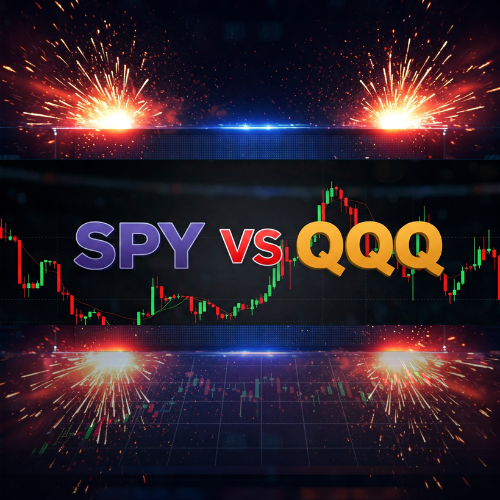
SPY Stock vs QQQ Stock: Which Index ETF Is Better for Your Goals?
Share
SPY Stock vs QQQ Stock: Which Index ETF Is Better for Your Goals?
For investors seeking efficient market exposure, two titans often dominate the conversation: SPY stock and QQQ stock. These powerhouse ETFs represent two of the most widely traded securities in the world, yet they offer meaningfully different exposures and characteristics that can significantly impact your investment outcomes.
But which one better serves your specific financial goals? And is the either/or question possibly missing a more sophisticated approach altogether?
Let's unpack these market-leading ETFs from the ground up, compare their critical differences, and explore how modern portfolio management approaches might allow you to optimize your experience with either—or both.
Understanding the Giants: SPY vs QQQ at a Glance
Before diving into strategic comparisons, let's establish a clear foundation on what each ETF actually represents:
SPY Stock: The Original Index ETF
SPDR S&P 500 ETF Trust (SPY) holds the distinction of being the first ETF ever created in the United States. Launched in 1993, it remains the most heavily traded ETF in the world with typical daily volume exceeding 60 million shares.
What SPY Tracks: The S&P 500 Index, representing approximately 500 of the largest U.S. companies weighted by market capitalization. This index captures roughly 80% of the total U.S. stock market value.
Key Stats:
- Total Assets: Over $400 billion
- Expense Ratio: 0.09%
- Style: Large-cap blend with proportional sector representation
- Dividend Yield: Typically 1-2%
- Inception: January 1993
QQQ Stock: The Tech-Tilted Powerhouse
Invesco QQQ Trust (QQQ) tracks the Nasdaq-100 Index and has become synonymous with growth-oriented investing, particularly with its heavy concentration in technology companies.
What QQQ Tracks: The Nasdaq-100 Index, representing the 100 largest non-financial companies listed on the Nasdaq exchange.
Key Stats:
- Total Assets: Over $200 billion
- Expense Ratio: 0.20%
- Style: Large-cap growth with technology overweight
- Dividend Yield: Typically lower than SPY (often below 1%)
- Inception: March 1999
Ready to get started? Explore the entry level guide Index Rebalancing- Smarter Index ETF Investing.
Inside the Indexes: Critical Differences That Impact Performance
While both ETFs provide exposure to many leading American companies, their underlying indexes differ in ways that dramatically impact their behavior across different market environments.
1. Sector Composition: The Technology Tilt
The most striking difference between SPY stock and QQQ stock lies in their sector allocations:
SPY's Sector Balance:
- Information Technology: ~25-30%
- Healthcare: ~13-15%
- Financials: ~10-13%
- Consumer Discretionary: ~10-12%
- Communication Services: ~8-10%
- Plus representation across industrials, energy, utilities, real estate, etc.
QQQ's Concentrated Exposure:
- Information Technology: ~50-55%
- Communication Services: ~15-20%
- Consumer Discretionary: ~15-18%
- Healthcare: ~5-8%
- Minimal exposure to other sectors
This concentration gives QQQ its distinctive character—it's essentially a technology-plus-growth ETF wearing an index fund costume.
2. Financial Sector Exclusion
QQQ stock explicitly excludes financial companies due to the construction rules of the Nasdaq-100 Index. This means no exposure to banks, insurance companies, investment firms, or real estate investment trusts.
This exclusion has had significant implications during various market cycles:
- Beneficial during the 2008 financial crisis when banks collapsed
- Detrimental during periods of rising interest rates when financial stocks often outperform
- A structural difference that explains performance divergence during certain economic transitions
3. Component Overlap with Different Weights
One fascinating aspect of these ETFs is their significant company overlap but with dramatically different weightings. Both SPY and QQQ include many of the same mega-cap companies like Apple, Microsoft, Amazon, and Google—but QQQ assigns them substantially higher portfolio percentages.
For example:
- Apple and Microsoft might each represent 6-7% of SPY but 10-15% of QQQ
- The top 10 holdings in SPY typically account for ~25-30% of the portfolio
- The top 10 holdings in QQQ often represent ~50-55% of the entire fund
This concentration difference means QQQ effectively makes a bigger bet on a smaller number of companies.
4. Market Representation: Broad vs. Curated
SPY aims to represent the broader U.S. economy by including companies across all major sectors. QQQ, by design, captures a more selective slice of the market, focusing on innovation-driven growth companies while excluding significant portions of the economy.
Neither approach is inherently superior—they simply serve different objectives.
Historical Performance: The Numbers Behind the Narratives
No discussion of these ETFs would be complete without acknowledging their historical performance patterns. While past results never guarantee future outcomes, they do illustrate how structural differences manifest across various market environments.
Recent Performance Comparison
Over the past decade (as of early 2025), QQQ has generally outperformed SPY during most calendar years. This outperformance stems primarily from:
- Technology's dominant role in market gains
- The secular growth of digital transformation across industries
- QQQ's higher concentration in mega-cap tech winners
However, this outperformance hasn't been universal. During periods of:
- Rising interest rates
- Sector rotation toward value
- Market stress that punishes concentration
SPY has often demonstrated more resilience due to its broader diversification and sector balance.
Volatility Trade-offs
With QQQ's higher growth potential comes notably higher volatility:
- Standard deviation (measure of price fluctuation): Typically 15-25% higher for QQQ vs SPY
- Larger drawdowns during market corrections
- More pronounced upside during tech-favorable rallies
This volatility profile makes perfect mathematical sense given QQQ's concentration—fewer companies means less internal diversification to smooth out fluctuations.
Strategic Applications: Which ETF Aligns With Your Goals?
Rather than declaring one ETF universally "better," thoughtful investors match their choice to specific financial objectives:
SPY May Be Better For:
Core Portfolio Foundation: If you're seeking a single-fund solution that provides broad market representation, SPY offers more comprehensive exposure than QQQ.
Lower Volatility Preference: Investors nearing retirement or those with lower risk tolerance often appreciate SPY's more balanced sector exposure and relatively lower volatility.
Income Focus: SPY historically provides a higher dividend yield than QQQ, making it somewhat more attractive for income-oriented strategies.
Economic Cycle Diversification: SPY's inclusion of sectors like utilities, consumer staples, and energy provides exposure to defensive and inflation-sensitive segments that QQQ largely lacks.
QQQ May Be Better For:
Growth Emphasis: Investors specifically seeking concentrated exposure to innovative growth companies may prefer QQQ's technology-forward composition.
Longer Time Horizons: Those with multi-decade investment horizons might accept QQQ's higher volatility in pursuit of potentially higher long-term returns.
Technology Conviction: Investors with strong conviction about continued technology outperformance might use QQQ as a more efficient vehicle than individual stock selection.
Sector Rotation Complement: QQQ can serve as an effective tactical tool for increasing technology exposure during favorable market cycles.
Beyond Either/Or: The Case for Strategic Combination
While many discussions frame SPY stock and QQQ stock as competing alternatives, sophisticated portfolio construction might incorporate both, potentially enhanced through systematic management approaches.
Complementary Allocation Strategy
Rather than choosing exclusively, many investors maintain a core position in SPY for broad market exposure while allocating a satellite position to QQQ for enhanced growth potential.
For example:
- 70% SPY provides foundational market exposure
- 30% QQQ adds growth emphasis without dominating the risk profile
This blended approach allows participation in technology's growth potential while maintaining broader economic diversification.
Dynamic Optimization Through Micro-Rebalancing
Both SPY and QQQ exhibit distinctive volatility characteristics that make them excellent candidates for more sophisticated position management approaches like Micro-Rebalancing.
Under a Micro-Rebalancing framework:
- Each ETF position receives a fixed Target Allocation (TA)
- Predetermined deviation thresholds trigger mechanical adjustments
- When positions fall below their lower threshold, shares are accumulated
- When positions rise above their upper threshold, shares are trimmed
This systematic approach transforms the natural volatility of both ETFs from something merely to endure into a potential mathematical advantage—without requiring market predictions or timing.
Interestingly, QQQ's higher volatility actually creates more frequent rebalancing opportunities, potentially enhancing the mathematical advantage of such systems while maintaining your desired exposure to the growth-oriented index.
Ready to supercharge your returns? Dive into The Art of the Micro-Rebalance: The New Financial Frontier for a full look into Micro-Rebalancing, including real-world examples with spreadsheets and trade confirmations. The VIP Access Edition provides additional bonuses and resources.
Making Your Decision: A Framework for ETF Selection
When evaluating SPY stock versus QQQ stock for your portfolio, consider these guiding questions:
-
Time Horizon: How many years will these funds remain invested before needed?
- Longer horizons (15+ years) might better tolerate QQQ's higher volatility
- Shorter horizons may favor SPY's broader diversification
-
Risk Capacity: How well can your financial plan absorb significant temporary declines?
- Higher risk capacity might accommodate QQQ's concentration
- Lower risk capacity might suggest SPY's more balanced profile
-
Growth Objectives: What annual return is necessary to achieve your financial goals?
- Higher required returns might necessitate QQQ's growth emphasis
- Moderate return needs might be satisfied with SPY's broader exposure
-
Income Requirements: Will you rely on these investments for current income?
- Income needs favor SPY's typically higher dividend yield
- Growth-focused investors might accept QQQ's lower income generation
-
Existing Portfolio Context: What other investments will complement these ETFs?
- SPY might pair well with existing sector-specific holdings
- QQQ might balance more conservative fixed-income allocations
Common Implementation Questions
"Should I dollar-cost average into these ETFs?"
While lump-sum investing has historically outperformed on average, dollar-cost averaging into either SPY or QQQ can help manage psychological barriers and reduce timing risk. More sophisticated approaches like Micro-Rebalancing offer a systematic framework that combines elements of both strategies.
"Can I hold both in the same portfolio?"
Absolutely. Many sophisticated portfolios include both SPY and QQQ in proportions aligned with their overall investment objectives. The key is understanding the overlapping exposure and intended role of each position.
"How should I rebalance between them?"
Traditional annual rebalancing works, but more responsive approaches like Index Rebalancing or Micro-Rebalancing provide systematic frameworks for optimizing positions based on actual market movements rather than calendar dates.
"What about other comparable ETFs?"
While we've focused on the two most widely traded options, comparable alternatives include:
- VOO (Vanguard S&P 500 ETF) as an alternative to SPY with a slightly lower expense ratio
- QQQM (Invesco Nasdaq 100 ETF) as a lower-cost alternative to QQQ for long-term holders
- IVV (iShares Core S&P 500 ETF) as another SPY alternative with minor structural differences
Evolution Beyond Basic Buy-and-Hold
While simple buy-and-hold approaches to either SPY or QQQ have created substantial wealth for millions of investors, modern trading innovations have opened doors to more sophisticated optimization strategies.
Systems like Index Rebalancing and Micro-Rebalancing provide mechanical frameworks for potentially enhancing traditional ETF investing by:
- Establishing fixed Target Allocations for each position
- Creating predetermined deviation thresholds (typically 1-5%)
- Systematically accumulating shares when positions fall below their lower threshold
- Methodically trimming when positions rise above their upper threshold
This structured approach creates a framework for consistently buying lower and selling higher without attempting to predict market direction—you're simply responding to actual price movements with mathematical precision.
Conclusion: The Right ETF Depends on Your Goals
The SPY vs QQQ question ultimately has no universal answer—the "better" choice depends entirely on your specific financial objectives, time horizon, and overall portfolio strategy.
For maximum diversification and lower volatility, SPY provides the more balanced approach. For growth emphasis with technology concentration, QQQ offers potentially higher returns with corresponding higher volatility.
Many sophisticated investors find room for both in their portfolios, often enhanced through systematic management approaches that transform the distinctive volatility characteristics of each ETF into potential mathematical advantages.
Whether you choose SPY, QQQ, or a strategic combination of both, the most important factor is establishing a consistent, disciplined approach aligned with your long-term financial goals—ideally one that turns normal market volatility from something to fear into an opportunity for systematic optimization.
Looking to enhance your approach to ETF investing? Explore our guide to Micro-Rebalancing for a systematic framework that works with both SPY and QQQ to potentially optimize your ETF positions without relying on market predictions.
